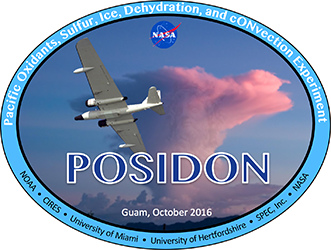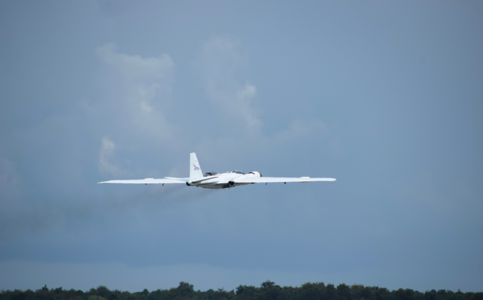Pacific Oxidants, Sulfur, Ice Dehydration, and cONvection (POSIDON) - a tropical Western Pacific high altitude experiment

Where: Guam
When: October 2016
Who: Investigators include ESRL CSD and GMD, the Cooperative Institute for Research in Environmental Sciences (CIRES), NASA and the Bay Area Environmental Research Institute (BAERI), SPEC Inc., the University of Miami, and the University Hertfordshire, UK.
The NASA Pacific Oxidants, Sulfur, Ice, Dehydration, and cONvection (POSIDON) Experiment is a focused airborne science mission to study the ozone distribution, sulfur chemistry, very short-lived ozone depleting species (VSLS), cloud microphysics, and dehydration in the tropical upper troposphere and lower stratosphere over the western Pacific. The mission will be conducted from Guam using the NASA WB-57F aircraft, which can reach altitudes above 60,000 ft. The aircraft will sample the atmosphere above the warmest waters of the Pacific Ocean where the Earth's coldest tropopause temperatures exist. In this region towering convective clouds are ubiquitous and tropospheric total ozone is extremely low. Related processes impact the transport of atmospheric pollutants and water vapor into the upper atmosphere. Data collected during this mission will provide new constraints to improve climate models.

Measurements from 12 specialized instruments aboard the NASA WB-57F and multiple launches of an ozone/aerosol/water vapor balloon package will be used for understanding processes controlling cloud microphysics and chemical species transport into the stratosphere. NOAA ESRL CSD and GMD federal and cooperative institute (CIRES) researchers and engineers have designed, built, and installed five of the 12 POSIDON WB-57F instruments and all of the balloon packages. A new NOAA instrument that measures SO2 with a detection limit more than an order of magnitude lower than previously achieved in high altitude operation will provide insight into the contribution of SO2 to the stratospheric sulfur budget. One of the mission principal investigators is from NOAA ESRL CSD. ESRL CSD is also providing flight planning and meteorology/forecasting products in support of POSIDON activities. Other project participants are from NASA research centers, a private company, and US and UK universities.
Research flights will occur during October 2016. Follow the POSIDON in the field blog led by CIRES researchers.